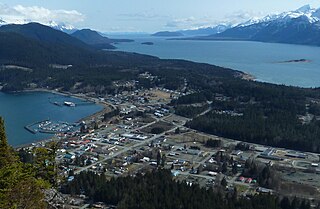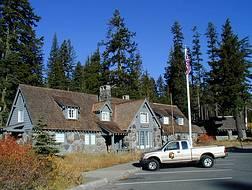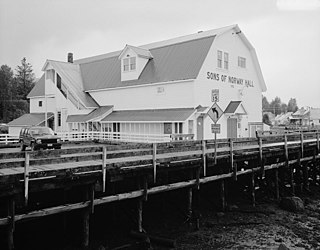
Haines is a census-designated place located in Haines Borough, Alaska, United States. It is in the northern part of the Alaska Panhandle, near Glacier Bay National Park and Preserve.

The Klehini River is a large, glacially fed stream in the vicinity of Haines in the U.S. state of Alaska.

The Eldred Rock Light is an historic octagonal lighthouse adjacent to Lynn Canal in Alaska. It is the last of the ten lighthouses constructed in Alaska between 1902 and 1906. It was also the last of 12 manned lighthouses that were started in Alaska. It is listed on the National Register of Historic Places as Eldred Rock Lighthouse.

The Five Finger Islands Light is a lighthouse located on a small island that lies between Stephens Passage and Frederick Sound in southeastern Alaska. It and Sentinel Island Light Station were the first U.S. government lighthouses opened in Alaska, first lit on March 21, 1902.

Castle Hill also known as the American Flag-Raising Site and now as the Baranof Castle State Historic Site, is a National Historic Landmark and state park in Sitka, Alaska. The hill, providing a commanding view over the city, is the historical site of Tlingit and Russian forts, and the location where Russian Alaska was formally handed over to the United States in 1867. It is also where the 49-star United States flag was first flown after Alaska became a state in 1959.

The Warner Valley Ranger Station, also known as the Warner Valley Patrol Cabin and Quarters 304, is located in the southern portion of Lassen Volcanic National Park, on the access road to the Drakesbad Guest Ranch. Built in 1926, it is unusual in its choice of construction method. While it resembles a log cabin, it was built using stacked milled 2x6 lumber to form the walls. It is the only such building known to have been built in this manner in the western regions of the National Park Service system. The interlocking boards extend past each other at the corners, forming a decorative detail.

The Watchman Lookout Station No. 168 is one of two fire lookout towers in Crater Lake National Park in southern Oregon. For many years, National Park Service personnel used the lookout to watch for wildfires during the summer months. It is also a common hiking destination because of its views of Crater Lake and the surrounding area. The building is unusual because it serves the dual purpose of fire lookout and museum. The Watchman Lookout Station is listed on the National Register of Historic Places.

Munson Valley Historic District is the headquarters and main support area for Crater Lake National Park in southern Oregon. The National Park Service chose Munson Valley for the park headquarters because of its central location within the park. Because of the unique rustic architecture of the Munson Valley buildings and the surrounding park landscape, the area was listed as a historic district on the National Register of Historic Places (NRHP) in 1988. The district has eighteen contributing buildings, including the Crater Lake Superintendent's Residence which is a U.S. National Historic Landmark and separately listed on the NRHP. The district's NRHP listing was decreased in area in 1997.

This is a list of the National Register of Historic Places listings in Haines Borough, Alaska.

Anchorage Depot, also known as Alaska Railroad Depot, is the railroad station at the center of the Alaska Railroad system at the junction of the two main lines their trains run on. It serves as the starting point for many tourists traveling on the luxury trains such as the Denali Star. The station is a Moderne-style three story concrete building, built in 1942 and enlarged in 1948.

The Sons of Norway Hall, also known as Fedrelandet Lodge #23, is a historic fraternal society building on Indian St. in Petersburg, Alaska. It is a large two-story wood-frame structure with a gambrel roof, measuring about 105 feet (32 m) in length and 55 feet (17 m) in width. Built in 1912 by volunteers, it was the first Sons of Norway lodge building built in Alaska. The hall was built large enough to stage events involving the entire community of Petersburg, and it was used for many years for all types of civic, social, public, and private events. During World War II it was used as an armory, and it served as a National Guard headquarters in the 1960s.

The Russian Bishop's House, once the Russian Mission Orphanage, is a historic house museum and National Historic Landmark at Lincoln and Monastery Streets in Sitka, Alaska. Built in 1841–43, this log structure is one of the oldest surviving buildings of Russian America, and was one of the centerpieces of the Russian Orthodox church's efforts to spread its influence among the natives of Alaska. It was the home and administrative center of Ivan Veniaminov, the first Bishop of Alaska, later canonized as Innocent of Alaska. The house is now a unit of Sitka National Historical Park, and is administered by the National Park Service.
The Central House, also known as Erickson & Stade's, at Mile 128 on the Steese Highway in Central, Alaska, was a log structure built in 1926 by Riley Erickson and John Stade, replacing an 1894 log and sod structure that was burned in a 1925 fire. It served as a roadhouse restaurant and hotel, and was listed on the National Register of Historic Places in 1978.
The Charlie Anway Cabin is a historic log cabin near Haines, Alaska, United States. It was built out of hewn logs in 1903 by Charles H. Anway, the first homesteader to settle in the Haines area. When first built, the cabin was L-shaped with a cross-gable roof with wood shingles. Anway later extended the building, giving it a T shape, and added a layer of metal from flattened cans; the roof has since been covered in galvanized corrugated sheet metal. Anway settled here and eventually produced crops which he sold at Fort William H. Seward. He farmed until 1932, and died in 1949. The cabin and two outbuildings are now owned by the Chilkoot Valley Historical Society.

The Mayflower School, now known as Juneau Montessori School, is a historic school building at St. Ann's and Savikko Streets in the Douglas part of Juneau, Alaska. It is significant as the only surviving historic Native school building in the Juneau-Douglas area. It is also the only Colonial Revival style BIA school in Alaska. Its nomination to the National Register of Historic Places in 1988 asserts the school was "a source of great pride to the Douglas Native community" and that it "represents a significant tie with the past for many Douglas Native people."

The Palmer Depot is a historic train station at South Valley Way and Evergreen Avenue in Palmer, Alaska. It is a large three-section single story frame structure, built in 1935 to provide transportation services to the newly established Matanuska Valley Colony. The main section is the former warehouse, which is 94 feet (29 m) long. The next section, with a lower profile than the warehouse, housed baggage facilities, a passenger waiting area, and living quarters for the station agent. The third section, the smallest of the three, houses the former ticketing office. The building now houses a community center.

The Puhl House, also known as the Bacon House, is a historic house at the corner of Scott Road and Glenn Highway in Palmer, Alaska. It is a rectangular single-story log structure measuring 35 by 25 feet, built out of round logs joined by saddle notches at the corners. The diameter and length of the logs reduces as they rise to the eaves; oakum chinking is used to close the gaps. The house was built in 1935 by Joe and Blanche Puhl, settlers who were part of the Matanuska Valley Colony settlement project. This building is distinctive as a colony house because it was not built by the crews of the Works Progress Administration that built most of the colony's housing; the Puhls organized their own construction team and acquired materials for its construction on their own.

The Fairbanks Exploration Company Machine Shop is a historic machine shop in Fairbanks, Alaska, United States. Located behind the Fairbanks Exploration Company administration building at 612 Illinois Street, it is a large single-story steel-frame structure, built in 1927 to serve the company's nearby gold mining operations. Its easternmost section is 16 feet (4.9 m) high, while that on the west is 20 feet (6.1 m) high, in order to accommodate belt-driven equipment and cranes. A tall double door at the center of the east facade is the main entrance. The front of the building housed large belt-driven lathes, while the center had a welding shop, drill presses, and a tool room. A blacksmithy in the back had a sand floor. The building was used by the F.E. Company between 1927 and 1964.
The Fairbanks Exploration Company Dredge No. 2 is a historic gold mining dredge in a remote area of Fairbanks North Star Borough, Alaska, northeast of the city of Fairbanks. It is currently located on the north bank of Fish Creek, shortly northeast of the mouth of Slippery Creek. Its main structure is a compartmented steel hull, 128 feet (39 m) long, 60 feet (18 m) wide, and 12 feet (3.7 m) high, with a 1-2 story superstructure above made of steel and wood framing sheathed in corrugated metal. It has three gantries, and a digging ladder 112 feet (34 m) long at its bow that weights 178,000 pounds (81,000 kg). All of its original operating equipment was reported to be in place in 1999. The dredge was built in 1927 by the Bethlehem Steel Company, and assembled for use in Alaska in 1928. It was operated by the Fairbanks Exploration Company in the Goldstream Valley from 1928 to 1949, and on Fairbanks Creek and lower Fish Creek from 1950 to 1961.

Chilkat State Park is a 9,837-acre Alaska state park on a peninsula south of the town of Haines, Alaska between the Chilkat and Chilkoot inlets. Remote and known for the steep 14% grade gravel access road, the park offers campsites with minimal amenities and is open to fishing, hiking, boating, sea kayaking, and sightseeing. The campground is closed from October to mid-May due to winter concerns.



















